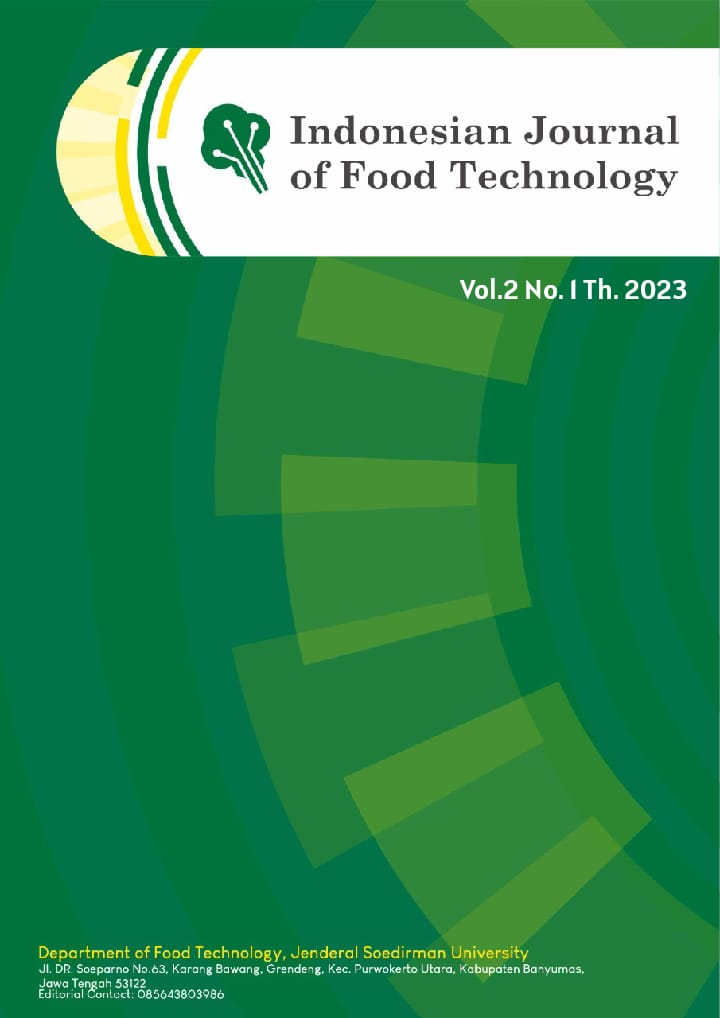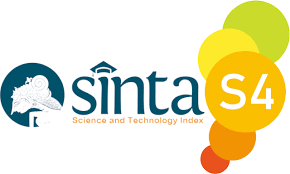Engineering in the Production of Crystal Coconut Sugar Enriched with Vitamin A and its Preference Tests for Consumers
Abstract
Coconut sugar is a food product that has the potential to be fortified with Vitamin A. This study aims to assess the quality of crystalline coconut sugar with vitamin A and test its preference for consumers. The experimental design used Split Plot Design with two treatment factors and 4 replications. The first treatment as the Main Plot (Main Plot) is the type of raw material for crystalline coconut sugar, which consists of 2 variations, namely: M1 = pure sap, and M2 = printed coconut sugar + 5% granulated sugar. The second treatment as a sub-plot was the proportion between palm oil as a solvent and carrots as a source of carotene (Vitamin A), which consisted of 3 variations, namely: S1= 1 : 1 (v/b), S2 = 1 : 2 (v/b), and S3= 2 : 1 (v/b). Physicochemical data were analyzed by F test and followed by 5% DMRT test, while organoleptic properties data were analyzed by Friedman test and followed by multiple comparison test. The best treatment was analyzed by the effectiveness index method. The results showed that a good raw material for producing crystalline coconut sugar with low reducing sugar content and high sucrose content was pure coconut sap. The proportion between palm oil and carrots which can produce crystalline coconut sugar with high levels of carotene (pro vitamin A) is 1 : 2 (v/b). The treatment combination that can produce crystalline coconut sugar with vitamin A with quality according to SNI-SII No.0268-85 is the treatment of the type of raw material for crystalline coconut sugar from pure coconut sap and the proportion of palm oil as a solvent with carrots as a source of carotene 1 : 2 ( v/b). This combination of treatments produced crystalline coconut sugar with physicochemical and organoleptic properties as follows: carotene content of 9.015 mg/100g of material or the equivalent of 752 RE (Retinol equivalent), water content of 3.617 percent, total sugar content of 81.071 percent, sucrose content of 75.627 percent, sugar content 5.434 percent reduction, 0.753 percent ash content and 0.197 percent water insoluble material content, "very smooth" texture, "creamy" color, "strong" coconut aroma, "not felt" carrot unpleasant smell and level of consumer acceptance (preference) "like".
References
Dewan Standar Nasional. 1995. Standar Nasional Gula Palma. Dewan Standar Nasional. Jakarta. 15 hal.
Direktorat Gizi Departemen Kesehatan RI. 1985. Daftar Komposisi Bahan Makanan. Bharata Karya Akasara, Jakarta.
Djokomoeljanto, R., R. Darmono, Susanto dan Budi R. 1993. Kumpulan Naskah Lengkap Simposium GAKI. Kongres Nasional III Perkeni. Badan Penerbit Universitas Diponegoro. Semarang.
Dwianti, H., Rumpoko dan Budi S. 2003. Kajian Kualitas Gula Kelapa Cetak yang Difortifikasi dengan Vitamin A dari Sumber Karoten yang berbeda. Laporan Penelitian SPP/DPP Unsoed. (Tidak Dipublikasikan).
Hadisaputro, S., T. Sukartono, Sudarjono, H. Setyawan, B. Basuki, T. Djokomoeljanto, Banandari, A.Sartono, A. Udijono, Darmono dan B. Sutrisno. 1997. Survei Pemetaan Gangguan Akibat Kakurang vitamin A (KVA) di Jawa Tengah Tahun 1996. Tim GAKI Fakultas Kedokteran Universitas Diponegoro dan Kanwil Depkes Propinsi Jawa Tengah. Semarang. 115 hal.
Mustaufik dan Karseno, 2004. Penerapan dan Pengembangan Teknologi Produksi Gula Semut Berstandar Mutu SNI untuk Meningkatkan Pendapatan Pengrajin Gula Kelapa di Kabupaten Banyumas. Laporan Pengabdian Masyarakat. Program Pengembangan Teknologi Tepat Guna. Jurusan Teknologi Pertanian Unsoed, Purwokerto.(Tidak dipublikasikan)
Mustaufik, Sutiarso, L., Rahayu, S., & Widodo, K. H. (2022). Technique engineering of tapping and shelter of coconut sap and its effect on the quality of crystal coconut sugar. Food Research, 6(2), 248–254. https://doi.org/10.26656/fr.2017.6(2).220
Nikmah, F. 2004. Pengaruh Saat Fortifikasi dan Lama Penyimpanan terhadap Sifat Kimia dan Sensorik Gula Kelapa Cetak Bervitamin A. Skripsi. Jurusan Teknologi Pertanian Fakultas Pertanian Unsoed, Purwokerto.(Tidak dipublikasikan).
Nurhadi, B., Sukri, N., Saputra, R. A., Wandhani, F. I., & Nurlita, A. I. (2020). Physical Characteristics of Amorphous and Crystalline Coconut Sugar Powder with the Addition of Tricalcium Phosphate (TCP) as an Anticaking Agent. International Journal of Food Science, 2020. https://doi.org/10.1155/2020/5320173
Nurhadi, B., Sukri, N., Sugandi, W. K., Widanti, A. P., Restiani, R., Noflianrini, Z., Rezaharsamto, B., & Herudiyanto, M. (2018). Comparison of crystallized coconut sugar produced by traditional method and amorphous coconut sugar formed by two drying methods: Vacuum drying and spray drying. International Journal of Food Properties, 21(1), 2339–2354. https://doi.org/10.1080/10942912.2018.1517781
Okoma, D. M. J., Konan, K. J. L., & Assa, R. R. (2020). Vitamin and Osidic Composition of Table Sugars from the Inflorescences Sap of 03 Coconut Cultivars (<i>Cocos nucifera</i> L.) in Ivory Coast. Food and Nutrition Sciences, 11(12), 1117–1126. https://doi.org/10.4236/fns.2020.1112079
Satriani, R., & Pramono, T. B. (2022). Added Value of Crystal Coconut Sugar in Women Farmers Group Tetes Mancung Cilongok District Banyumas Regency. Indonesian Journal of Food Technology, 1(1), 80. https://doi.org/10.20884/ijft.v1i1.6139
SNI, 1992. Cara Uji Makanan dan Minuman. SNI. 01 – 2891
Suryana P., Sandjaja dan S. Herman. 1995. Metode Alternatif untuk Mendeteksi Garam Bervitamin A. Jurnal Ilmiah Gizi Indonesia; 20 (1): 50 – 59.

This work is licensed under a Creative Commons Attribution-ShareAlike 4.0 International License.










